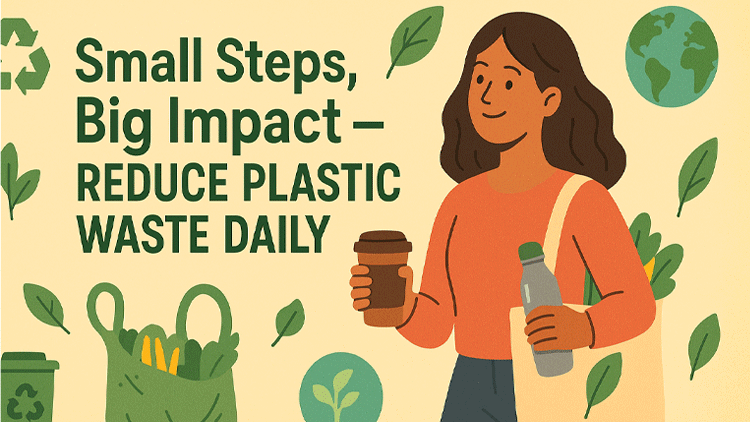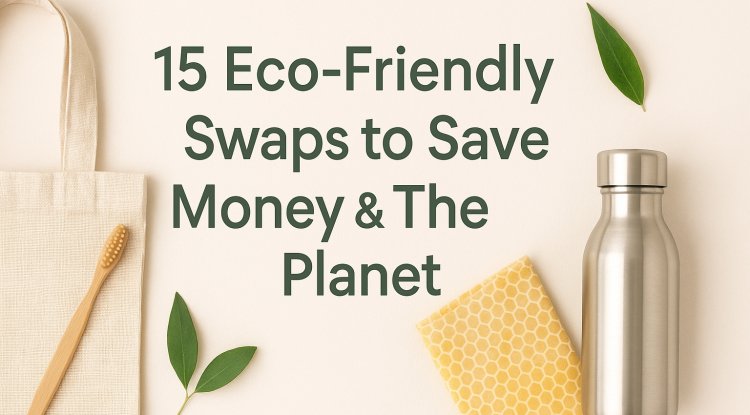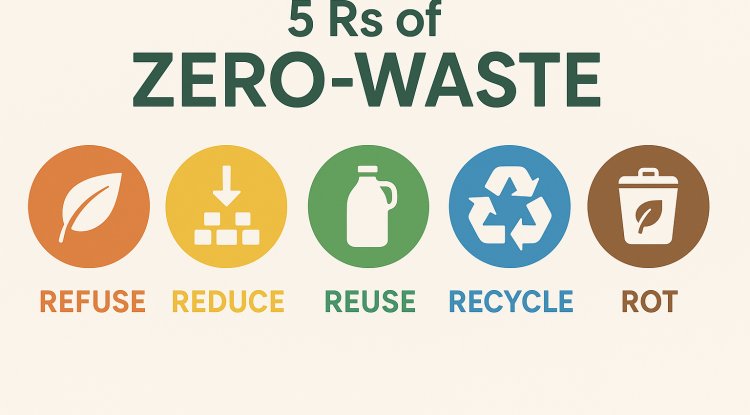Zero-Waste Lifestyle: शुरुआती लोगों के लिए आसान स्टेप-बाय-स्टेप गाइड
Zero-Waste Lifestyle क्या है और इसे कैसे अपनाएँ? इस आसान स्टेप-बाय-स्टेप गाइड में जानें कचरा कम करने, री-यूज़ और कम्पोस्टिंग के तरीके। छोटा बदलाव, बड़ा असर।
Zero-Waste Lifestyle: Beginner’s Step-by-Step Guide
In a world facing climate change, overflowing landfills, and plastic-polluted oceans, the concept of a zero-waste lifestyle has emerged as a practical and mindful way to reduce our environmental footprint. While the term “zero-waste” might sound intimidating—as though you must fit a year’s worth of trash into a mason jar—it’s actually more about progress, not perfection. The goal is to rethink how we consume, reduce what we discard, and make choices that align with a more sustainable future.
If you’re curious about going zero-waste but don’t know where to start, this beginner’s step-by-step guide will help you make the transition without overwhelm.
What Is a Zero-Waste Lifestyle?
A zero-waste lifestyle focuses on minimizing the waste we send to landfills and incinerators. Instead, it emphasizes:
-
Refusing unnecessary items (like freebies or single-use plastics)
-
Reducing consumption of things we don’t truly need
-
Reusing items as much as possible
-
Recycling properly, as a last resort
-
Rotting (composting) organic waste
This concept is often summarized by the 5 Rs of Zero-Waste: Refuse, Reduce, Reuse, Recycle, Rot. Unlike short-lived eco-trends, zero-waste is more of a mindset—a commitment to living in harmony with nature while still enjoying modern conveniences in mindful ways.
Why Adopt a Zero-Waste Lifestyle?
Before diving into steps, it’s important to understand why zero-waste matters:
-
Environmental Protection – Less waste means reduced pollution, fewer plastics in the oceans, and lower greenhouse gas emissions.
-
Resource Conservation – By reusing and recycling, we extend the life of resources like water, minerals, and trees.
-
Healthier Living – Zero-waste often means avoiding processed, packaged foods and toxic materials.
-
Financial Savings – Buying less, repairing more, and using durable products saves money over time.
-
Mindful Consumption – It encourages intentional choices that simplify life and bring more meaning.
Step-by-Step Beginner’s Guide to Zero-Waste
Step 1: Start with Awareness
The first step isn’t to buy bamboo toothbrushes or glass jars—it’s to notice your current habits. Spend a week paying attention to what you throw away. Do you toss lots of food scraps? Plastic water bottles? Shopping receipts?
This “waste audit” will give you a baseline. Awareness makes change easier because you know where your biggest impact lies.
Step 2: Embrace the 5 Rs
Learn and practice the hierarchy of zero-waste:
-
Refuse what you don’t need (say no to straws, free pens, or plastic bags).
-
Reduce what you do use (cut back on impulse purchases).
-
Reuse items (carry a reusable bottle, repair clothes).
-
Recycle properly (check local recycling rules).
-
Rot (compost food scraps).
This order matters—recycling isn’t the first step; it’s one of the last.
Step 3: Swap Single-Use for Reusables
Single-use plastics are one of the biggest contributors to waste. Start by replacing the most common items you use daily:
-
Carry a reusable water bottle instead of buying bottled water.
-
Use a cloth shopping bag instead of plastic bags.
-
Bring a reusable coffee cup to cafés.
-
Switch to metal or bamboo straws if you use straws often.
-
Pack lunches in stainless steel or glass containers.
These small swaps add up quickly and save you money in the long run.
Step 4: Simplify Your Kitchen Habits
Kitchens generate a huge amount of waste—from food packaging to spoiled groceries. Here’s how to cut it down:
-
Buy in bulk: Bring your own containers to stores with bulk bins.
-
Choose unpackaged produce: Skip the plastic-wrapped vegetables.
-
Plan meals: Prevent food waste by buying only what you’ll eat.
-
Compost scraps: Turn organic waste into nutrient-rich soil instead of tossing it.
-
Cook more, order less: Homemade meals reduce packaging waste.
Step 5: Rethink Personal Care Products
The bathroom is another area filled with disposable items. Some beginner-friendly swaps include:
-
Bar soap & shampoo bars instead of bottled liquids.
-
Bamboo toothbrushes instead of plastic.
-
Safety razors instead of disposable razors.
-
Cloth pads or menstrual cups instead of single-use products.
-
Refillable skincare instead of small plastic tubes.
These alternatives not only reduce waste but also often use healthier, natural ingredients.
Step 6: Minimize Clothing Waste
Fast fashion is a major global polluter. To make your wardrobe more sustainable:
-
Buy less, choose better: Invest in durable, timeless pieces.
-
Shop second-hand: Thrift stores and online resale apps are treasure troves.
-
Repair before replacing: Sew small tears or replace buttons.
-
Donate or swap clothes you no longer wear.
Think of your clothes as long-term investments, not disposable trends.
Step 7: Make Your Home Low-Waste
At home, little changes add up:
-
Switch to LED bulbs to save energy.
-
Use cloth towels instead of paper towels.
-
Replace chemical cleaners with vinegar, baking soda, and lemon—effective, cheap, and safe.
-
Buy furniture and home items second-hand or sustainably made.
Every home has different priorities, so start where it feels easiest for you.
Step 8: Practice Conscious Shopping
Every purchase is a vote for the kind of world you want. Before buying, ask:
-
Do I really need this?
-
Can I borrow, rent, or find it second-hand?
-
Is it made to last, or will it break quickly?
-
Is the packaging recyclable or compostable?
Conscious shopping reduces clutter and helps avoid waste before it enters your home.
Step 9: Get Creative with Reuse
Zero-waste often sparks creativity. For example:
-
Glass jars can store pantry items, leftovers, or even become plant pots.
-
Old T-shirts can be cut into cleaning rags.
-
Shoe boxes can organize drawers.
-
Gift wrapping can be done with scarves, newspapers, or reusable bags.
Reusing isn’t just eco-friendly—it’s fun and resourceful.
Step 10: Build a Community Mindset
Zero-waste isn’t about perfection; it’s about collective effort. Share tips with friends, join local swap groups, support eco-conscious businesses, and advocate for sustainable policies. When communities participate, small steps multiply into big impact.
Common Myths About Zero-Waste
-
“It’s too expensive.”
In reality, buying less and reusing more saves money over time. Many swaps (like reusable bottles or menstrual cups) pay for themselves quickly. -
“You have to be perfect.”
Zero-waste is about reducing waste, not eliminating it entirely. Progress matters more than perfection. -
“It’s only for people with access to bulk stores.”
Even without bulk shops, you can reduce waste by composting, reusing, and refusing unnecessary items.
Tips to Stay Motivated
-
Start small—choose one area (like grocery shopping) before tackling everything.
-
Celebrate small wins—each reusable bag or composted apple core makes a difference.
-
Follow zero-waste blogs, podcasts, or social media accounts for inspiration.
-
Remind yourself that every step, however small, helps the planet.
Conclusion
A zero-waste lifestyle isn’t about depriving yourself—it’s about redefining what “enough” means. By taking small, intentional steps, you can live more sustainably, save money, and simplify your life. Whether you start with a reusable bottle, a compost bin, or a thrift-store wardrobe, every action contributes to a healthier planet.
Remember: you don’t need a handful of people doing zero-waste perfectly—you need millions doing it imperfectly. Start where you are, use what you have, and let your journey unfold one step at a time.
What's Your Reaction?






















